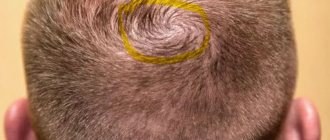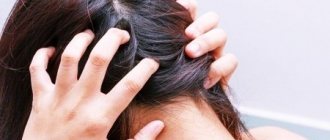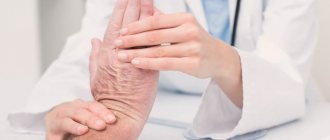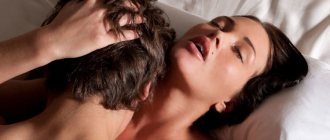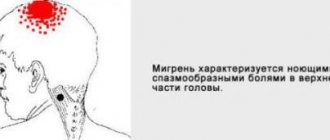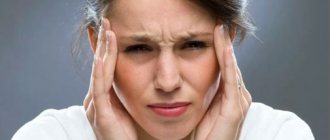Glaucoma:
Throbbing pain on the right side of the head can begin in those who have a disease such as glaucoma. In this case, a person feels an increase in intraocular pressure, during which the eyes hurt, the eyelids turn red, nausea, weakness appear, and vision deteriorates. The insidiousness of this disease is that at first it does not manifest itself in any way.
If throbbing pain in the head is present in the back of the head, then it may indicate some kind of infectious disease, or if there are tumors in the brain. But these diseases can be reliably stated when pulsation occurs regularly. If these are isolated cases, they occur in the following conditions:
- when a person drank coffee and abruptly gave it up. Ripple occurs because the vessels cannot quickly return to normal after an overstrained state;
- when smoking;
- during an incorrect position during sleep;
- after experiencing overvoltages of various types.
Such pain goes away when a person quits smoking, gives up coffee and is less nervous about various little things.
Characteristics of pain
Painful sensations localized in the occipital zone often arise due to provoking factors (insufficient sleep, overwork, injury) or may be a symptom of pathology. Often pain in the right side of the head is accompanied by characteristic neurological symptoms:
- Tinnitus, hearing problems of neurosensory etiology.
- Attacks of nausea, often ending in vomiting.
- Numbness, convulsions, spasms in the extremities.
- Dizziness, transient states of confusion.
- Impaired motor coordination.
Neurological symptoms are always a sign of damage to the structures of the nervous system. Features of painful sensations may indirectly indicate the cause of the occurrence. Types of pain localized in the back of the head on the right:
- Pulsating with increasing intensity. Usually occurs due to arterial hypertension.
- Increased pain after head movements or general physical activity. Often occurs against the background of muscle tissue diseases.
- Constantly recurring attacks of spontaneous, acute pain in the right side of the head in the occipital region, followed by attenuation. Indirectly indicates a pathology such as Barré-Lieu syndrome, also known as cervical migraine.
- Severe headache in the back of the head on the right, radiating to the frontal, temporal, parietal region. Characteristic of vertebral artery syndrome (impaired blood circulation in the circulatory system located inside the spine, compression of the nerve roots located in the area of the vertebral artery).
If attacks of cephalalgia recur, it is necessary to undergo examination and determine the cause of the disturbances. Otherwise, without treatment, the disease will progress, significantly worsening a person’s quality of life.
Types of throbbing pain in the head in various diseases
If a person focuses on his sensations in the back of his head, understands how long the pulsation lasts and what its frequency is, he can himself determine the presence of a particular disease.
- If the pulsation begins in the morning and there is a feeling of heaviness in the head and an increased heart rate, this is a sign of pressure changes, often hypertension. In some cases, along with these signs, pain in the temples is observed.
- Regular pulsation in the temples of the head indicates the presence of VSD. Often dizziness and nausea are added to the pulsation.
- A slight throbbing pain in the back of the head and a feeling that the pain is radiating to the ear or jaw is the result of hypothermia or the onset of a cold or infection.
- Pulsation in the back of the head and temporal part, as well as in the temples, and this pain is accompanied by weakness throughout the body, perhaps blood vessels are pinched somewhere or a spasm has occurred.
- Symptoms of cervical migraine are sudden attacks of pulsation, while flashes appear in the eyes.
- With cervical osteochondrosis, a strong pulsation occurs in the back of the head, in addition, it becomes dark in the eyes and noise in the ears appears.
- Pain in the back of the head, which spreads to the right side of the head, in the temple area, indicates a strong jump in intracranial pressure, migraine or vasospasm.
Causes of throbbing pain in the head on the right
Throbbing pain in the right side of the head is not a disease, but a symptom of a number of diseases. In rare cases, it can occur in a healthy person, and it can be very intense. However, it is important to undergo a full examination, since more often it indicates diseases of blood vessels and nerves, neoplasms and other dangerous disorders.
Psychogenic headache
One of the causes of throbbing pain in the right side of the head is nervous tension, stress and high mental stress. A separate category is psychogenic headache, which accompanies various mental disorders:
- with neurasthenia, the headache can be throbbing, pressing, occur only in the left or right side, or spread over the entire surface;
- with hysteria this is a rare symptom; patients find it difficult to indicate the exact location of the painful area;
- depression, hypochondria - with these diseases, an acute, throbbing headache manifests itself when exposed to a traumatic factor.
Psychogenic headaches can be relieved with painkillers or non-steroidal anti-inflammatory drugs. It goes away completely after successful treatment of the underlying disease, as well as during periods of remission.
Migraine
Unilateral throbbing pain in the head on the right side is a typical symptom of migraine. The disease is manifested by attacks of pain that occur for no apparent reason. Its exact cause is unknown, but the role of impaired cerebral blood flow has been proven. Changes in pressure and deterioration in blood movement through the vessels lead to the manifestation of a classic migraine - a one-sided throbbing headache.
Before the onset of an attack, a migraine “aura” often develops. This is a set of symptoms that can be used to determine the imminent deterioration of well-being. These include sensitivity to light and smells, increased activity, or emotional depression. The following factors can trigger an attack:
- sharp sounds, smells, bright lighting;
- violation of sleep patterns, physical activity and nutrition (fasting);
- some products, often sweets;
- changes in weather conditions;
- stress, emotional tension.
If the headache is moderate, it goes away after proper rest. At home, you can take anti-inflammatory and painkillers (Ibuprofen, Spazmalgon). Your doctor may also recommend specific anti-migraine medications (Sumatriptan).
Vascular diseases
Arteritis is a group of diseases that are manifested by inflammation of the walls of the arteries. They can be infectious or non-infectious in origin, and most often occur in old age. If the disease affects the vessels of the head, it is accompanied by acute, throbbing pain in the head on the right or left side. In some patients, lumps may be felt on the temples - nodules that are located in inflamed areas.
Treatment of arteritis is carried out under the supervision of a physician. According to indications, the following groups of drugs may be prescribed:
- medications that stimulate blood circulation (Pentoxifylline);
- to restore the vascular wall (Actovegin);
- antispasmodics (Spazmalgon, No-Shpa);
- non-hormonal and steroidal (Prednisolone) anti-inflammatory drugs - the latter can only be taken with a doctor's prescription.
Arteritis requires timely treatment, otherwise it can progress and pose a threat to the patient’s life. Additional symptoms appear, including changes in scalp sensitivity, blurred vision, and increased body temperature. Inflammation of the vessels of the head can develop simultaneously with venous diseases (phlebitis, thrombophlebitis) and pathologies of the heart vessels.
Throbbing pain in the head on the right side with diseases of the ENT organs
If the pain throbs in the head on the right, this may be a sign of diseases of the ENT organs. They cause mechanical compression of blood vessels, swelling, and the spread of infection through the bloodstream is also possible. There are several pathologies that are characterized by the appearance of an acute, throbbing, unilateral headache.
- Inflammation of the nasal sinuses (sinusitis, sinusitis) is a chronic disease in which exudate accumulates in the cavities of the paranasal sinuses. If normally they are empty, then with sinusitis they are filled with liquid or viscous contents. Swelling of the mucous membrane and difficulty breathing are also observed.
- Otitis is an inflammation of the ear. Especially dangerous is purulent internal otitis, which is characterized by acute pain and the danger of infection spreading to the membranes of the brain.
- Injuries or neoplasms of the hearing organs are the cause of constant intense headaches. It appears only on the affected side, covering the ear and temple area.
Treatment is prescribed individually. In different cases, broad-spectrum antibiotics, anti-inflammatory and painkillers are used. Surgical intervention may also be required: puncture of the nasal sinuses to extract contents, removal of tumors.
Neuralgia
Pain that pulsates from the right side of the head is a characteristic sign of neuralgia. It represents acute pain due to inflammation or damage to the nerves. Acute attacks are short-lived and rarely exceed 30–60 seconds, but are highly intense. They appear suddenly and pass quickly; the rest of the time a nagging headache may persist. It is one-sided, but over time it can cover the entire surface of the head.
Trigeminal neuralgia is more common. It originates from the 5th pair of cranial nerves and is divided into 3 branches: the orbital, maxillary and mandibular nerves. They innervate the dura mater of the brain, soft tissues of the cranial vault, as well as skin, muscles and mucous membranes. Its inflammation is accompanied by a throbbing headache, often one-sided, temporary blurred vision, and impaired sensitivity of the facial skin. Treatment takes place only under the supervision of a doctor. The regimen includes painkillers and anti-inflammatory drugs, novocaine blockades, anticonvulsants and other drugs.
Intoxication and poisoning
Acute headache is one of the first signs of intoxication. Poisoning can be caused by solid, liquid or volatile substances that enter the body with inhaled air or through the digestive tract. These include heavy metals, mercury, alcohol, carbon monoxide and other compounds. The products of their metabolism accumulate in the tissues of the nervous system and provoke an acute, throbbing headache. Additional symptoms also appear:
- increased blood pressure;
- pulsation in temples;
- noise in ears;
- nausea and vomiting;
- cardiopalmus.
At the first signs of poisoning, you should consult a doctor, otherwise the symptoms may progress. In later stages, the patient experiences convulsions, breathing problems and pulmonary edema. To relieve intoxication, it is important to restore the balance of fluids and electrolytes (droppers); if possible, an antidote is used, which reduces the harmful effects of the toxic substance and reduces the concentration of toxins in the blood.
Neoplasms
For unilateral headaches, it is important to exclude the possibility of tumors. They vary in shape and size and can be benign or malignant. Some of them do not grow, others can reach large sizes over time. It is necessary to determine the size of the tumor, its type and histological features, as well as its tendency to growth and malignancy. Based on these data, the doctor makes a decision on the treatment regimen.
In the initial stages, tumors may not show any signs. Some patients complain of a constant headache concentrated in a certain area. Symptoms depend on the exact location of the tumor and its size. A typical clinical picture may include persistent nausea, impaired hearing, vision and coordination of movements, and mental disorders.
There is a throbbing pain in the head: when should you see a doctor?
There are situations in which a visit to the doctor is inevitable, and the sooner the better for a person to dull the pain at an early stage. So, you should visit a doctor if:
- The throbbing pain does not go away for several hours.
- Intense pain does not stop for several days and brings significant discomfort
- Pain in the back of the head begins in the early morning.
- If the pressure increases during pulsation, you must definitely call an ambulance to avoid a hypertensive crisis.
What to do if a symptom occurs
To alleviate pain before visiting a specialist, the first step is to restore normal sleep and give the body a rest. To do this, you can take an infusion of valerian. You should avoid drinking strong coffee drinks that contain caffeine. Instead, it is better to brew tea with the addition of thyme, mint and chamomile. You can reduce pain by applying cold to the place where it appears; for this it is better to make a compress using ice.
During the period of migraine and severe pain on the right side of the head, discomfort can be reduced with the help of special massage actions. To do this, you should very carefully massage the area where the pain is coming from with your fingers. The duration of such a massage should be at least 10 minutes. It must be remembered that in cases where the pain is caused by tumors, massage is prohibited.
You also need to know that folk remedies can help relieve discomfort only with mild symptoms. In the event of cerebral hemorrhages, vomiting, or dizziness, self-medication is prohibited. In such cases, effective treatment should only be determined by a specialist, since such manifestations cannot always be cured with medication.
It is important to understand that the first step is to determine the reason why the pain appeared on the right side. It is necessary to undergo an examination consisting of the following procedures:
- a deep blood test that allows you to see all possible deviations from the norm;
- computed tomography - to identify possible tumors and problems with blood vessels that cause pain;
- ophthalmological examination – necessary to exclude problems with the visual organs.
Further prescription of therapeutic therapy will directly depend on the cause of pain. During the examination, in case of short-term pain, specialists allow you to take painkillers. Often the patient is recommended to take Analgin, Spasmalgon or Citramon, as they relieve spasms, help dilate blood vessels and stop pain.
If you have a severe migraine on the right side of your head, you should take an anti-inflammatory drug that will help eliminate fatigue and relieve pain. It is important to increase the amount of water you drink and get more rest, preferably in the fresh air.
Treatment
Before starting treatment, you must visit a neurologist, ophthalmologist and therapist. In some cases, you need to contact an infectious disease specialist. Since all doctors unanimously insist that headaches should not be tolerated under any circumstances, you need to take one of the following medications:
- Citramon;
- Farmadol;
- No-shpa;
- Aspirin.
Even if a strong pulsation is felt, the dosage of the above medications cannot be exceeded, since the body will not receive any benefit. After taking the tablet, you need to lie down in silence, because any physical activity leads to a significant increase in pain.
After the doctor has found out the cause of the throbbing pain in the left side of the head, right or back of the head, the patient, in addition to treatment, needs to carry out the following procedures to normalize the body’s condition:
- Perform a warming massage in order to warm up the blood vessels and improve the condition of osteochondrosis and neuralgia. In addition to massage, manual therapy will help improve your well-being.
- A soft and gentle massage will alleviate the condition of intracranial hypertension.
- Japanese acupressure will improve your well-being for various types of pain.
- Regularly measuring blood pressure and bringing it back to normal in a timely manner will help eliminate throbbing pain.
- Physiotherapy will be appropriate for osteochondrosis, neuralgia, increased intracranial pressure and various vascular changes.
- Doctors prescribe physical therapy for all types of throbbing pain.
- Surgery is inevitable for tumors and other serious diseases.
As you can see, throbbing pain in the head is a symptom of many diseases. Therefore, you must definitely consult with a specialist or call an ambulance, because home methods can only get rid of mild pain.
Types of pain
Cephalgia manifests itself in the following types:
- Tension pain. A person perceives this type of pain as compression of the head, both on both sides and on one. Subjectively, it seems as if the eyes and forehead are trying to escape from the head. Typically, an attack of tension pain lasts up to half an hour.
- Migraine is a throbbing pain in the head on the right side, but the location of pain in migraine is not a defining feature. Cephalalgia extends to the eyes, mouth, jaws and neck. A migraine attack can last several hours.
- Cluster pain. This type is characterized by burning and stabbing pain on one side of the face. It is perceived as a sharp headache in the right hemisphere. Accompanied by redness and sweating on the painful side. Cluster pain is combined with nasal congestion and lacrimation. The cluster type of cephalgia is manifested by attacks that last from 15 minutes to several hours.
- Pain in the back of the head on the right may occur after drinking coffee. A large amount of caffeine affects the tone of blood vessels in the brain - this causes pain. Cephalgia can also occur with abrupt withdrawal of the drink. For example, if a person constantly drinks coffee and does not drink it one day, he risks getting headaches.
- A headache on the back of the head on the right is one of the symptoms of hypertension or high blood pressure. Most often, cephalalgia with hypertension is manifested by throbbing pain. Unpleasant sensations are accompanied by numbness, blurred vision, low performance and nosebleeds.
- Rebound pain. This type of cephalalgia appears after taking medications as a side effect. A paradoxical phenomenon: painful sensations can occur with long-term use of painkillers. The way out of the situation is to discontinue the drug, which causes a side effect.
- Dull and aching pain. Occurs with tumors in the brain. The tumor mechanically compresses areas of the brain and skull, thereby affecting the nerve endings, which leads to pain. Typically, such cephalgia appears in the morning and is accompanied by vomiting.
- Costen's syndrome. Some infectious and rheumatic diseases lead to damage to the maxillofacial joint, which is accompanied by pain on the right side. Also hurts: ear, sinus, tongue.



